By Shelbi Etscorn
In a previous article, I spoke about what it’s like today working at the MROI. Today I’d like to tell you a bit about the history of the project and how we got to where we are today.

The history of the site where the Magdalena Ridge Observatory now sits goes back almost 100 years. In the 30s and 40s it was used as a site for atmospheric research being conducted by Vincent Schafer, Bernard Vonnegut (brother of the famed author Kurt Vonnegut), and Dr. Irving Langmuir (Nobel laureate and namesake of the future Langmuir Laboratory). It wasn’t until the 60s that a true road would be carved into the mountainside allowing access for the supplies and materials needed to build the main Langmuir research facility.
Around this time Stirling Colgate became the President of New Mexico Tech and used his influence to continue construction on the laboratory. He also oversaw the construction of the Joint Observatory for Cometary Research and the Digital Supernova Telescope.

Throughout the 60s and 70s additions were added to the facilities on the mountain and in 1980, Ronald Reagan signed a law that established the Langmuir Research site. In 1982 the NRAO developed and proposed the concept of a millimeter array. Magdalena Ridge was a top contender for the spot where they would build this array, however it was eventually built in Chile, now the Atacama Large Millimeter/submillimeter Array(ALMA). The spot up on Magdalena Ridge was now associated with being a potential spot for an observatory.

It wasn’t until 1994 that a report coming out of the White Sands Missile Range indicated the lack of a fast tracking telescope to track missile launches was affecting the military’s ability to carry out its research, and in 1995 a phone conversation between Dr. David Westpfahl of New Mexico Tech and Dr. Dick Newton from the Army broached the topic of the Government’s need of a telescope. Dr. Westpfahl suggested a telescope atop Magdalena Ridge, and the very next day the two visited the sight. And so began the long road that would lead to establishing the MRO.
In 1996 the Magdalena Ridge Observatory Consortium was formed. Included in this consortium was New Mexico Tech, the Air Force Research Lab, the US Army, New Mexico State University, and others. Together they raised fund and helped pass legislation that would allow construction to begin on the MRO.
In the late 1990s a 2.4m mirror was declassified by NASA and the US government. This mirror was one of many made as part of the bidding process to choose the company that would make the mirror that would be used on the Hubble Space Telescope. The company that made this particular mirror lost the bid unfortunately; however, their misfortune was the MRO’s gain who quickly acquired the mirror which would later be used to create the 2.4m telescope at the observatory.
After many years of finding funding and getting approval, construction on the 2.4 m telescope finally began in 2003 and was completed in 2006. The MRO had its first working telescope!

Going back a few years though, the Summer School on Space and Ground Based Optical and InfraRed Interferometry was being held in Leiden, Germany. At this time “Gary Loos and David Westpfahl presented a comprehensive overview of the MRO 3-element Interferometer concept. It was there that Loos met Chris Haniff from the Cavendish Laboratory at the University of Cambridge who, with his colleague David Buscher, presented a poster on a proposed 10-element Large Optical Array (LOA) based on their experience with the COAST interferometer in the UK” (From the Clouds to the Stars, I. Payne). Here both pairs of men shared their ideas on their different concepts for an interferometer, and the location of Magdalena Ridge was again brought into a conversation about a possible site to build.
Finally, in 2004 a Memorandum of Understanding was signed between the University of Cambridge, UK, and New Mexico Tech. Chris Haniff and David Buscher became the System Architects for the 10-element Magdalena Ridge Observatory Interferometer.

The rest of the story is contracts and funding, construction and finagling. But it still stands that if Magdalena Ridge hadn’t been discovered and recognized for its potential for a place of research, if the NRAO hadn’t decided against building ALMA there and instead moved their construction to Chile, if Dave Westpfahl had never had that phone conversation with Dick Newton, and if Gary Looz and Dave Westpfahl had never ran into Chris Haniff and David Buscher in Germany, the MRO might be very different than how we know it today, if it even would exist at all.
Events spanning almost 100 years had to happen for the MROI to finally be able to begin construction. Here’s hoping in another 100 years, the MROI will have been completed and all 10 elements of our optical array will be making discoveries we never could have imagined 200 years prior when everything was getting started.
